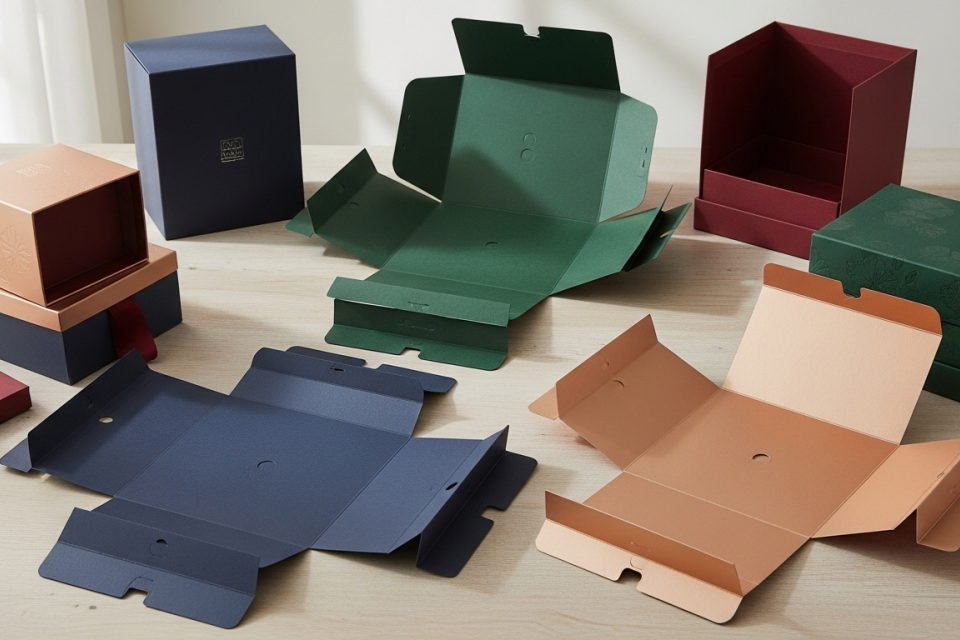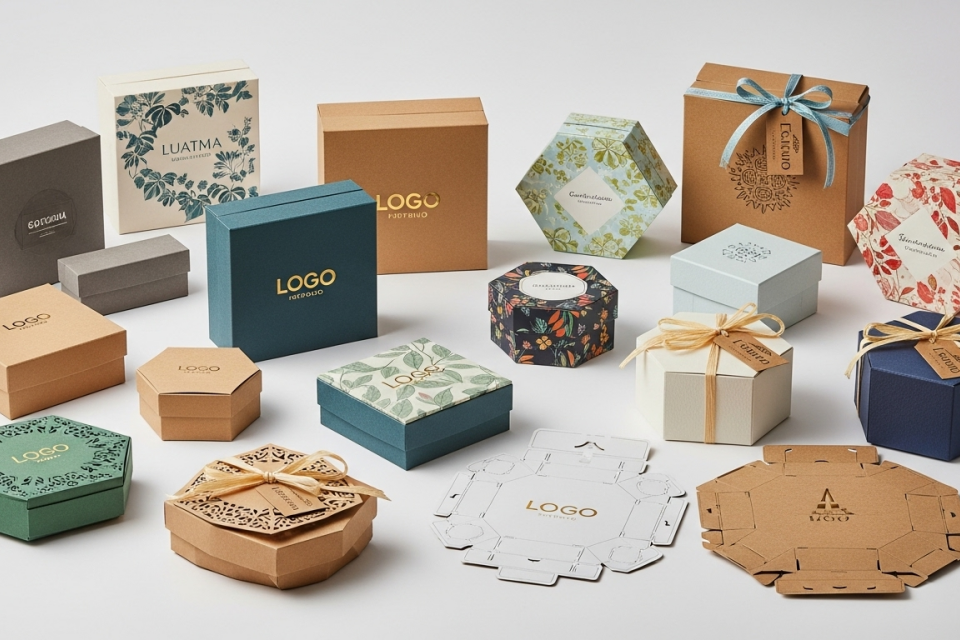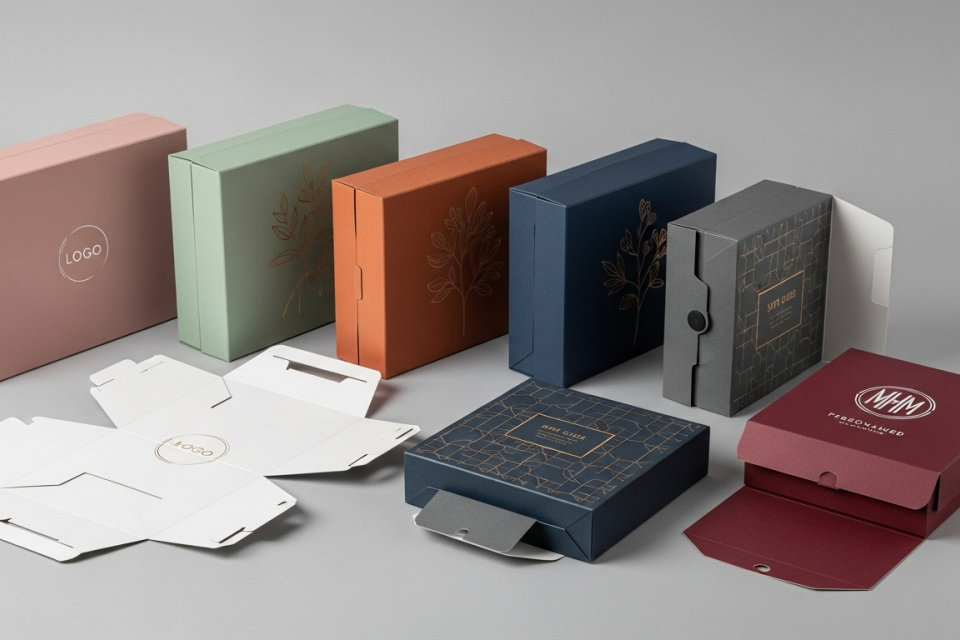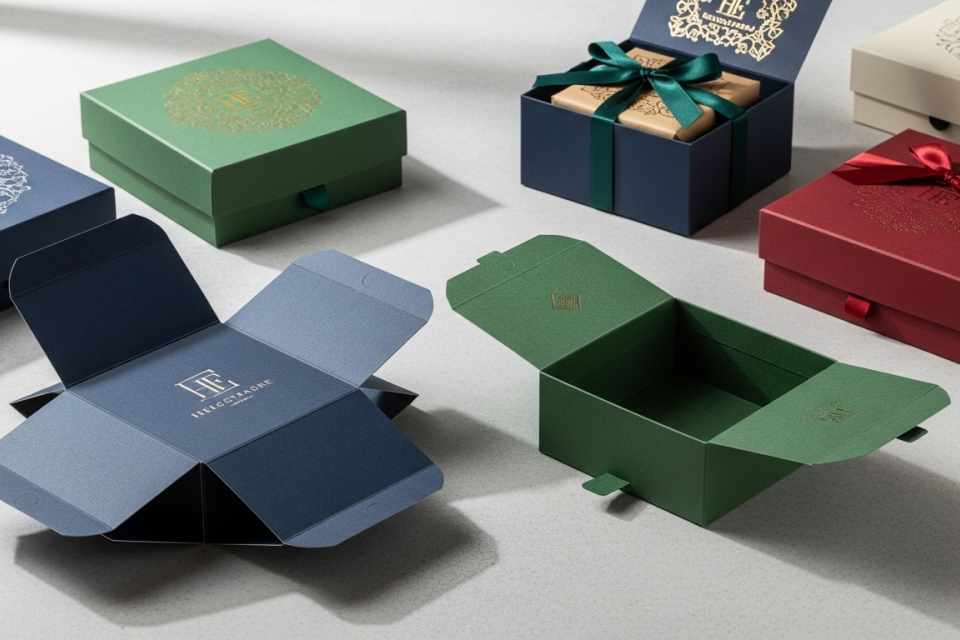How Do Collapsible Rigid Boxes Work
Explore collapsible rigid boxes, the packaging that marries luxury with practicality. This guide covers their space-saving design, sustainability benefits, and branding opportunities, showing how they cut costs.
Summary
Collapsible rigid boxes are innovative packaging solutions designed to combine aesthetic appeal with practicality, enabling significant space savings during storage and transportation. With the ability to reduce volume by over 60% compared to traditional rigid packaging, these boxes have become increasingly popular across various industries, including luxury goods, electronics, and consumer products. Their unique design not only caters to functional needs but also enhances the unboxing experience, making them an essential element in brand marketing and consumer engagement.
Notable for their structural innovations, collapsible rigid boxes feature advanced engineering that allows for various shapes and customized designs, from hexagonal to circular configurations. Manufacturers employ cutting-edge technology, such as automatic visual positioning production lines, to ensure quality and efficiency during the production process. However, the increased complexity in design can present challenges in terms of assembly and shipping logistics, as well as maintaining consistency in quality across large production runs.
The rise of environmental consciousness among consumers has also driven interest in collapsible rigid boxes, as they contribute to sustainability efforts by minimizing material waste and reducing transportation emissions. Despite these advantages, concerns regarding the sourcing of materials and the environmental impact of manufacturing processes remain pertinent, leading to ongoing discussions within the industry about sustainable practices.
Overall, collapsible rigid boxes represent a significant evolution in packaging design, balancing the demands of functionality, aesthetics, and environmental responsibility. Their growing market appeal highlights the potential for continued innovation, as brands seek to differentiate themselves through unique packaging solutions that not only protect products but also enhance the consumer experience.
Table of Contents
Design and Construction
Structural Design Innovations
Collapsible rigid boxes are characterized by their innovative structural design, which combines luxury presentation with practical efficiency. These boxes can achieve space savings of over 60% compared to traditional rigid packaging, making them an attractive option for brands across various industries. The design possibilities are extensive, including various shapes such as hexagonal, triangular, and circular configurations, although these designs require advanced engineering to ensure proper functionality during collapse and assembly. Manufacturers with cutting-edge production capabilities utilize automatic visual positioning box production lines, allowing them to produce complex designs while maintaining high quality and short production times.
Materials and Manufacturing Processes
The manufacturing of collapsible rigid boxes involves meticulous material selection and advanced production processes. High-grade paperboard is typically chosen for its strength, rigidity, and folding endurance, ensuring suitability for collapsible applications. Manufacturers often use paperboard with specific density specifications to strike a balance between durability and foldability. The production process employs sophisticated machinery that minimizes human error, enhances throughput, and ensures precise construction essential for the boxes’ collapsible features.
Customization and Design Features
Customization is a key aspect of collapsible rigid boxes, allowing brands to add unique design elements that enhance their packaging appeal. Designers often collaborate with clients to incorporate extravagant features while being mindful of the potential challenges that excessive design elements may present. By utilizing a variety of design techniques, brands can create visually striking packaging that stands out in the marketplace, provided that the design remains functional and practical.

Manufacturing Process
The manufacturing process of collapsible rigid boxes involves a series of advanced techniques designed to ensure both quality and efficiency. The evolution of these boxes began in the mid-20th century, with significant innovations paving the way for modern production methodologies. Early inventions like the semi-automatic wrapper “Natalina” introduced by SATE in 1956 laid the groundwork for automating box-making tasks, though substantial manual intervention remained necessary during this era.
Automation and Production Efficiency
From the 1960s to the 1980s, the industry shifted towards semi-automatic machinery, which significantly enhanced efficiency by automating discrete tasks within the box-making process. However, human operators were still required for material feeding and assembly steps, leading to a hybrid workflow that combined manual labor with automation. The introduction of specialized semi-automatic components allowed companies to selectively automate the most labor-intensive processes, further increasing productivity while maintaining the quality associated with artisanal box-making.
Today, the manufacturing of collapsible rigid boxes utilizes cutting-edge technologies, including automatic visual positioning production lines. These advanced systems employ optical recognition technology to align components precisely, ensuring structural integrity while minimizing inconsistencies that can occur in mass production. Each box undergoes rigorous testing for durability, fold resistance, and overall structural stability at multiple quality checkpoints, which is crucial for maintaining high-quality standards across large production runs.
Quality Control Measures
To guarantee premium presentation and functionality, quality assurance protocols are integrated throughout the production process. This includes raw material certification, die-cutting accuracy verification, and structural integrity testing. Leading manufacturers implement ISO9001-2015 Quality Management Systems to standardize these processes and facilitate continuous improvement. Such rigorous quality control ensures that collapsible rigid boxes not only meet aesthetic expectations but also maintain their structural integrity through repeated use and handling.
Furthermore, advanced manufacturing technologies facilitate consistent quality, enabling brands to uphold their identity and integrity across all customer touchpoints. By reducing labor costs and minimizing material waste through precise handling, these innovations lead to lower operational expenses and increased profitability for manufacturers.
Design Innovations and Customization
The versatility of collapsible rigid boxes is enhanced by their ability to incorporate sophisticated design features without compromising structural integrity. Patented folding mechanisms and interlocking components create robust structures that rival traditional rigid boxes, while allowing for extensive customization options such as embossing, foil stamping, and unique shapes. This capability enables brands to deliver visually striking packaging that aligns with their marketing goals while ensuring that the packaging remains durable and functional throughout its lifecycle.

Applications
Industry-Specific Applications and Customization
Collapsible rigid boxes have found extensive applications across various industries, particularly in sectors requiring durable packaging solutions for heavier items. Their substantial weight-bearing capacity makes them ideal for packaging luxury food items, electronics, and other fragile products. This versatility allows brands to customize their packaging to meet specific product protection requirements, ensuring optimal safeguarding regardless of the item being shipped or stored.
Shipping, Storage, and Assembly Logistics
The logistics of using collapsible rigid boxes have been optimized for efficiency. These boxes facilitate effective shipping and storage, enabling businesses to maximize warehouse density while minimizing the costs associated with transporting empty containers. Their foldable structure allows for significant space savings when not in use, making them particularly appealing to distribution centers and fulfillment hubs, especially in e-commerce settings driven by giants like Amazon and Walmart. Additionally, the rise of work-from-home trends has led to an increase in online shopping for luxury and gift items, further driving the demand for robust packaging solutions that not only protect products during transit but also enhance the consumer experience during unboxing.
Custom Services and Client Support Excellence
Brands utilizing collapsible rigid boxes can benefit from comprehensive client support systems that streamline the packaging process from initial design to final delivery. Customization options allow businesses to create bespoke packaging solutions that align with their branding and marketing strategies, effectively using packaging as a means to communicate brand value to consumers.
Creating Memorable Unboxing Experiences
The design and structure of collapsible rigid boxes contribute significantly to creating memorable unboxing experiences, particularly for luxury items. Their premium feel and visual appeal play a crucial role in elevating the perceived value of products, thereby justifying premium pricing strategies. As packaging increasingly becomes an integral part of brand storytelling, the importance of effective specialty packaging in enhancing customer engagement and satisfaction cannot be overstated.
Sustainability Integration
Modern applications of collapsible rigid boxes also emphasize sustainability, with brands seeking to use responsibly sourced materials while maintaining luxury appeal. The integration of eco-friendly practices in packaging design not only meets consumer demand for sustainability but also enhances the overall brand image.

Advantages
Collapsible rigid boxes offer a range of benefits that make them increasingly popular across various industries, especially in the context of sustainability and cost-effi- ciency.
Environmental Sustainability Factors
One of the primary advantages of collapsible rigid boxes is their substantial environmental impact. These packaging solutions are designed for transportation efficiency, capable of reducing shipping and storage costs by over 60% compared to standard gift boxes. This efficiency not only lowers fuel consumption but also minimizes greenhouse gas emissions throughout the supply chain, thereby contributing to a smaller carbon footprint for global brands. Furthermore, the production process of these boxes uses significantly less water and energy compared to traditional packaging materials, aligning with contemporary sustainability values.
Cost-Efficiency and Space-Saving Benefits
From a financial perspective, collapsible rigid boxes can yield significant savings. Although the initial production costs may be higher than standard folding cartons, the logistics savings associated with reduced shipping and storage space can offset this premium. The capacity to fold down and reduce volume when not in use leads to lower transportation costs and enhanced warehouse efficiency, making these boxes particularly advantageous for businesses with international shipping requirements or seasonal inventory fluctuations.
Enhanced Branding Opportunities
Collapsible rigid boxes are also effective tools for enhancing brand identity. Their customizable nature allows businesses to incorporate brand colors, logos, and other visual elements that contribute to a positive brand image. The unboxing experience can be significantly elevated through thoughtful design, leaving a lasting impression on customers and reinforcing brand recognition. Additionally, premium finishing techniques can be employed to create visually appealing packaging that stands out in competitive markets.
Durability and Extended Product Lifecycle
Another notable benefit is the durability of collapsible rigid boxes, which are built to withstand various handling conditions. This resilience supports an extended product lifecycle, allowing for repeated use and reducing the need for constant repurchasing of packaging materials. The ability to reuse these boxes not only supports sustainable practices but also reinforces the perceived value of the product contained within.
Customization and Design Versatility
The design versatility of collapsible rigid boxes allows for extensive customization options. Brands can experiment with shapes, finishes, and interactive features to create unique packaging that captivates consumers. This level of creativity not only enhances the consumer experience but also sets brands apart in a crowded marketplace, enabling them to convey their identity and values effectively.

Challenges
The implementation of collapsible rigid boxes in packaging presents several challenges that can affect production efficiency, quality control, and overall market acceptance.
Production Process and Quality Control Measures
One of the primary challenges lies in the production process, where maintaining consistency in quality and dimensions across multiple units can be difficult. Traditionally, manual production methods limited output volumes, making rigid boxes exclusive to high-value items, such as fine jewelry and delicate watches, due to the high cost per unit driven by labor-intensive practices. As demand grows for more economical and uniform packaging solutions, manufacturers must adapt their production techniques to ensure that the boxes meet both aesthetic and functional standards while scaling up output.
Shipping, Storage, and Assembly Logistics
The logistical challenges associated with shipping and storing collapsible rigid boxes also merit attention. The design of these boxes, while innovative, may require specific handling and assembly protocols to avoid damage during transit. Moreover, the geometry of the boxes can influence how they are stored and shipped, impacting overall supply chain efficiency. Different shapes may necessitate customized internal padding to protect contents, complicating logistics further.
Environmental Impact and Sustainability Considerations
Environmental concerns are increasingly shaping consumer preferences and regulatory landscapes. While collapsible rigid boxes can offer advantages in terms of material efficiency and reduced waste, manufacturers must address sustainability in sourcing materials and production methods to minimize their environmental footprint. This focus on sustainability can necessitate the adoption of advanced manufacturing technologies that may initially require significant investment, posing a barrier for some businesses looking to enter the market.
Advanced Production Technology and Equipment
To meet these challenges, companies may need to invest in advanced production technology and equipment. The integration of automation and robotics can enhance production speed and consistency but also involves substantial initial costs and workforce retraining. Balancing these technological investments with the need to retain the craftsmanship that defines collapsible rigid boxes remains a complex challenge for manufacturers.
By addressing these challenges, businesses can enhance the viability of collapsible rigid boxes in the market while ensuring they meet the evolving expectations of consumers and regulatory standards.
Future Trends
Sustainability in Production
The future of collapsible rigid boxes is heavily influenced by sustainability initiatives within the packaging industry. Manufacturers are increasingly adopting eco-friendly and recycled materials, alongside implementing closed-loop manufacturing processes that significantly reduce waste. Continuous research and development, often in collaboration with universities, enables the rigid box industry to advance sustainable practices while meeting the evolving demands of a global market.
Technological Advancements
Technological innovations, particularly in automation, are set to reshape the production landscape for collapsible rigid boxes. The transition to high-speed automation allows for mass customization, enabling manufacturers to create intricate and sophisticated designs that were previously difficult or cost-prohibitive to produce manually. This advancement leads to a substantial reduction in production errors, thereby increasing yield rates and minimizing material waste, which further contributes to environmental sustainability.
Efficiency and Cost-Effectiveness
Modern automated machinery can produce thousands of boxes per hour, significantly cutting cycle times and allowing businesses to meet high-volume demands and strict deadlines. The implementation of Internet of Things (IoT) systems enhances production line synchronization and diagnostics, leading to better throughput visibility and reduced bottlenecks. Moreover, automation not only increases production efficiency but also reduces labor costs and operational expenses, thus improving overall profitability for manufacturers.
Market Growth Projections
The collapsible rigid containers market is projected to experience robust growth, expanding from USD 2.17 billion in 2025 to USD 3.69 billion by 2034, with a compound annual growth rate (CAGR) of 5.4%. The demand for reusable and space-efficient packaging solutions is expected to rise as environmental concerns and green logistics become increasingly prioritized across various sectors. By 2025, crates are estimated to account for 42.8% of the market share, with plastic materials dominating over 59.2% of the market by the same year.
Customization Techniques
Customization remains a key trend in the design of collapsible rigid boxes. Techniques such as adding textured coatings, metallic foils, and specialty inks can enhance the visual and tactile experience for consumers, thereby adding perceived value to the product. As brands seek to differentiate themselves in a competitive market, the demand for unique and innovative packaging solutions will likely increase, pushing manufacturers to explore advanced finishing techniques to elevate their offerings.
